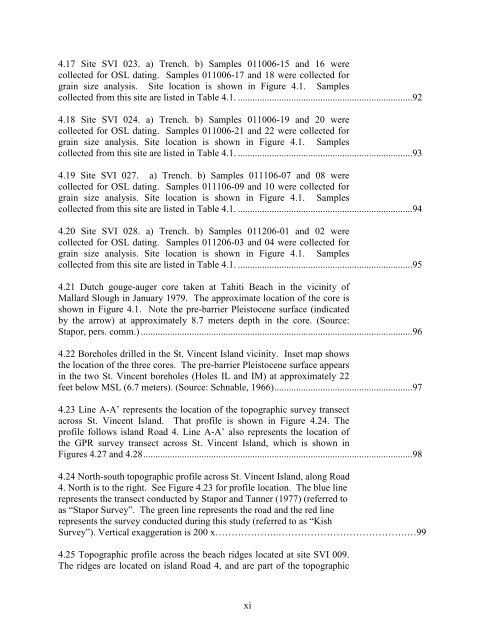the florida state university college of arts and sciences evolution of ...
the florida state university college of arts and sciences evolution of ...
the florida state university college of arts and sciences evolution of ...
You also want an ePaper? Increase the reach of your titles
YUMPU automatically turns print PDFs into web optimized ePapers that Google loves.
4.17 Site SVI 023. a) Trench. b) Samples 011006-15 <strong>and</strong> 16 were<br />
collected for OSL dating. Samples 011006-17 <strong>and</strong> 18 were collected for<br />
grain size analysis. Site location is shown in Figure 4.1. Samples<br />
collected from this site are listed in Table 4.1. ........................................................................92<br />
4.18 Site SVI 024. a) Trench. b) Samples 011006-19 <strong>and</strong> 20 were<br />
collected for OSL dating. Samples 011006-21 <strong>and</strong> 22 were collected for<br />
grain size analysis. Site location is shown in Figure 4.1. Samples<br />
collected from this site are listed in Table 4.1. ........................................................................93<br />
4.19 Site SVI 027. a) Trench. b) Samples 011106-07 <strong>and</strong> 08 were<br />
collected for OSL dating. Samples 011106-09 <strong>and</strong> 10 were collected for<br />
grain size analysis. Site location is shown in Figure 4.1. Samples<br />
collected from this site are listed in Table 4.1. ........................................................................94<br />
4.20 Site SVI 028. a) Trench. b) Samples 011206-01 <strong>and</strong> 02 were<br />
collected for OSL dating. Samples 011206-03 <strong>and</strong> 04 were collected for<br />
grain size analysis. Site location is shown in Figure 4.1. Samples<br />
collected from this site are listed in Table 4.1. ........................................................................95<br />
4.21 Dutch gouge-auger core taken at Tahiti Beach in <strong>the</strong> vicinity <strong>of</strong><br />
Mallard Slough in January 1979. The approximate location <strong>of</strong> <strong>the</strong> core is<br />
shown in Figure 4.1. Note <strong>the</strong> pre-barrier Pleistocene surface (indicated<br />
by <strong>the</strong> arrow) at approximately 8.7 meters depth in <strong>the</strong> core. (Source:<br />
Stapor, pers. comm.) ................................................................................................................96<br />
4.22 Boreholes drilled in <strong>the</strong> St. Vincent Isl<strong>and</strong> vicinity. Inset map shows<br />
<strong>the</strong> location <strong>of</strong> <strong>the</strong> three cores. The pre-barrier Pleistocene surface appears<br />
in <strong>the</strong> two St. Vincent boreholes (Holes IL <strong>and</strong> IM) at approximately 22<br />
feet below MSL (6.7 meters). (Source: Schnable, 1966).........................................................97<br />
4.23 Line A-A’ represents <strong>the</strong> location <strong>of</strong> <strong>the</strong> topographic survey transect<br />
across St. Vincent Isl<strong>and</strong>. That pr<strong>of</strong>ile is shown in Figure 4.24. The<br />
pr<strong>of</strong>ile follows isl<strong>and</strong> Road 4. Line A-A’ also represents <strong>the</strong> location <strong>of</strong><br />
<strong>the</strong> GPR survey transect across St. Vincent Isl<strong>and</strong>, which is shown in<br />
Figures 4.27 <strong>and</strong> 4.28...............................................................................................................98<br />
4.24 North-south topographic pr<strong>of</strong>ile across St. Vincent Isl<strong>and</strong>, along Road<br />
4. North is to <strong>the</strong> right. See Figure 4.23 for pr<strong>of</strong>ile location. The blue line<br />
represents <strong>the</strong> transect conducted by Stapor <strong>and</strong> Tanner (1977) (referred to<br />
as “Stapor Survey”. The green line represents <strong>the</strong> road <strong>and</strong> <strong>the</strong> red line<br />
represents <strong>the</strong> survey conducted during this study (referred to as “Kish<br />
Survey”). Vertical exaggeration is 200 x………………..………………………………….…99<br />
4.25 Topographic pr<strong>of</strong>ile across <strong>the</strong> beach ridges located at site SVI 009.<br />
The ridges are located on isl<strong>and</strong> Road 4, <strong>and</strong> are part <strong>of</strong> <strong>the</strong> topographic<br />
xi

















